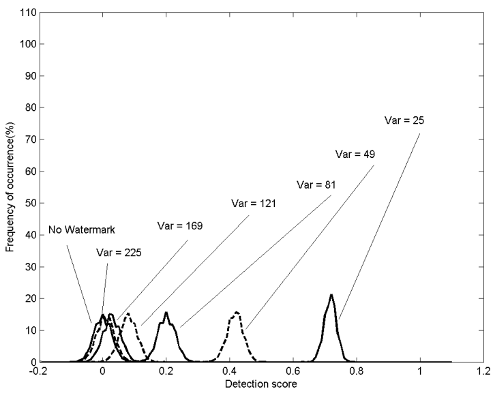Novel blind multiple watermarking technique for images
TLDR
Experimental results show that embedded watermarks using the proposed techniques can give good image quality and are robust in varying degree to JPEG compression, low-pass filtering, noise contamination, and print-and-scan.Abstract:
Three novel blind watermarking techniques are proposed to embed watermarks into digital images for different purposes. The watermarks are designed to be decoded or detected without the original images. The first one, called single watermark embedding (SWE), is used to embed a watermark bit sequence into digital images using two secret keys. The second technique, called multiple watermark embedding (MWE), extends SWE to embed multiple watermarks simultaneously in the same watermark space while minimizing the watermark (distortion) energy. The third technique, called iterative watermark embedding (IWE), embeds watermarks into JPEG-compressed images. The iterative approach of IWE can prevent the potential removal of a watermark in the JPEG recompression process. Experimental results show that embedded watermarks using the proposed techniques can give good image quality and are robust in varying degree to JPEG compression, low-pass filtering, noise contamination, and print-and-scan.read more
Figures

Fig. 30. (Left) MWE-watermarked image under LPF attack.PSNR = 31:82 dB. (Middle) Decoded watermark. (Right) Random watermark detection results. 
Fig. 26. Detection error of MWE under LPF attack. 
Fig. 6. (a) Original logo “UST”. (b)-(f) Original logo “Alphabet”. 
Fig. 23. Distribution ofS of MWE (IA-R, Q = 5) under JPEG attack. 
Fig. 28. Detection error of MWE under noise attack. 
Fig. 27. Distribution ofS of MWE under noise attack.
Citations
More filters
Proceedings ArticleDOI
Performance Evaluation of Multiple Watermarks System
Fan Zhang,Xinhong Zhang +1 more
TL;DR: A analysis of multiple watermarks system capacity is proposed, where two watermarks are embedded in an image at the same time, and the capacity is larger than the capacity when the single watermark is embedded, and is smaller than the sum of the capacity of two watermark are embedded respectively.
Journal ArticleDOI
Image watermarking via wavelet approach and face biometrics
TL;DR: A new highly-performing system to establish the intellectual property of a file by using advanced Information Fusion techniques based on Face Biometrics and Wavelet Multiresolution Analysis, and a new method, based on information entropy, to track the access and use of a specific file by different users.
Book ChapterDOI
Wavelet analysis based blind watermarking for 3-d surface meshes
TL;DR: This paper proposes a blind watermarking method based on wavelet analysis for 3-D mesh model that allows to detect the watermark without referring to the original meshes and proves that the method is fairly robust against various attacks including topological ones.
Journal ArticleDOI
Nonblind and quasiblind natural preserve transform watermarking
TL;DR: A quantitative measure is proposed to objectify performance; under this measure, the proposed technique outperforms most of the recent techniques in most cases.
Journal ArticleDOI
A certificate-based watermarking scheme for coloured images
TL;DR: The results of the authors' extensive experiments have proven the capability of the proposed technique as an efficient management mechanism and the robustness of it against various image processing attacks such as Joint Photographic Experts Group compression, low pass filtering and high pass filtering as well as noise contamination.
References
More filters
Journal ArticleDOI
Secure spread spectrum watermarking for multimedia
TL;DR: It is argued that insertion of a watermark under this regime makes the watermark robust to signal processing operations and common geometric transformations provided that the original image is available and that it can be successfully registered against the transformed watermarked image.
Book
Digital Watermarking
TL;DR: Digital Watermarking covers the crucial research findings in the field and explains the principles underlying digital watermarking technologies, describes the requirements that have given rise to them, and discusses the diverse ends to which these technologies are being applied.
Journal ArticleDOI
Hidden digital watermarks in images
Chiou-Ting Hsu,Ja-Ling Wu +1 more
TL;DR: The experimental results show that the proposed image authentication technique by embedding digital "watermarks" into images successfully survives image processing operations, image cropping, and the Joint Photographic Experts Group lossy compression.
Journal ArticleDOI
DCT-domain watermarking techniques for still images: detector performance analysis and a new structure
TL;DR: Analysis of a spread-spectrum-like discrete cosine transform (DCT) domain watermarking technique for copyright protection of still digital images is analyzed and analytical expressions for performance measures are derived and contrasted with experimental results.
Journal ArticleDOI
Rotation, scale, and translation resilient watermarking for images
TL;DR: It is shown that the watermark is robust to rotation, scale, and translation, and tests examining the watermarks resistance to cropping and JPEG compression.